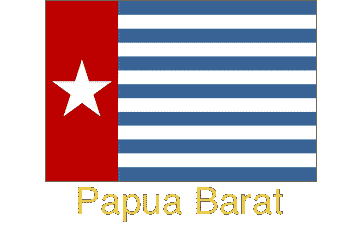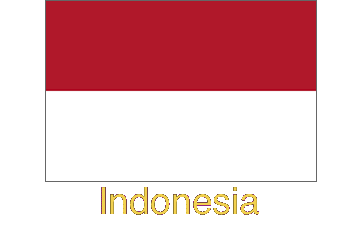Photos from West-Papua
| Home | About | Guestbook | Contact |
WEST-PAPUA - 1979
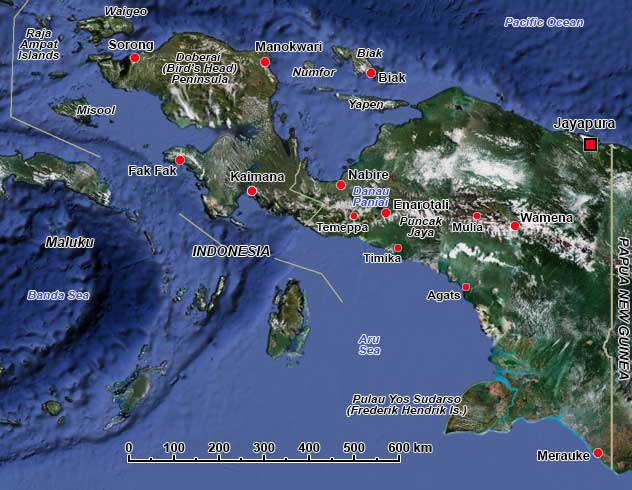
A short history of West-Papua
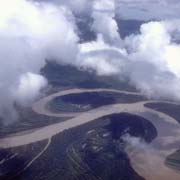
West-Papua is the western half of the island of New Guinea and the name preferred by the indigenous people; it is administered by Indonesia since 1962 and, in 2003, divided into two provinces: Papua and West-Papua (Papua Barat), a rather confusing situation as Indonesian officials refer to the latter as only the "Bird's Head" peninsula (Kepala Burung) and islands to its west, while independence activists refer to the whole region.
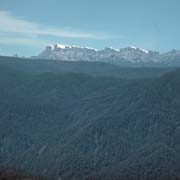
New Guinea is the world's second largest island and was named "Nueva Guinea" by Spanish explorer Yñigo Ortiz de Retez in 1545 as its coast reminded them of that of west Africa. About 20 years earlier, in 1526-27, Jorge de Menendez, a Portuguese explorer, named the main island "Papua", after the Malay "pepuah", which referred to the frizzy hair of the Melanesian inhabitants he saw. The island has been inhabited for at least 40,000 years and it seems agriculture was already practised in the interior at least 10,000 years ago. The island is very mountainous, with its highest point, now named Puncak Jaya in Indonesian, 5,005 metres above sea level. People have been living in isolated valleys for many centuries, resulting in around 1,000 separate languages spoken on the island. There are probably around 800 Papuan languages, on the island of New Guinea and also some neighbouring islands in Indonesia, East Timor, Papua New Guinea and even Australia (the Meriam Mir language in the Torres Strait). Other languages are Austronesian or Malayo-Polynesian.
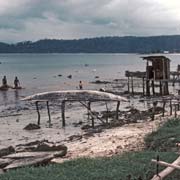
Although the Spanish navigator Luís Vaz de Torres, sailing along the south western coast, had claimed the territory for the Spain in 1606, nothing came of it. The north western coast, towards the end of the sixteenth century, came under influence of the Sultan of Ternate, an island in the northern Moluccas; the Sultan of Tidore, the island just east of Ternate, claimed sovereignty over the coast of New Guinea and, as the Dutch now held power over the Moluccas as part of their trading empire (the Vereenigde Oost-Indische Compagnie, the United East Indian Company) they recognised the Sultan's claim and so New Guinea became nominally Dutch. In 1793 the British had established a settlement near Manokwari which failed and in 1824 they agreed that western New Guinea would become part of the Dutch East Indies; this was formally recognised by Germany (it took possession of the north east of the island in 1884) and Britain (it proclaimed a protectorate over the south east in 1884 and annexed it 4 years later) in treaties of 1885 and 1895.
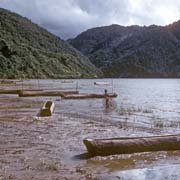
The Dutch set up settlements in Manokwari and Fak-Fak in 1896 but apart from mineral exploration in the 1930s, there was very little activity by the Dutch in the first half of the 20th century. A prison camp for Indonesian nationalists, Bovel Digoel, had been established in 1928 in Tanah Merah, an isolated place surrounded by jungle and hostile tribes; Mohammad Hatta and Sutan Sjahrir, who would become respectively Indonesia's first vice president and first Prime Minister, were held here. The Wissel Lakes and the Baliem Valley, in the highlands, were only discovered by air in 1936 and 1938. During the Second World War the Dutch East Indies, including Dutch New Guinea, was occupied by the Japanese and in 1944 the push to liberate it was begun by the Americans; a large amphibious operation captured the capital Hollandia and vicious battles were fought with huge Japanese losses on the islands, like Biak and Numfor. In 1945 Sukarno had declared independence of Indonesia, but the Dutch re-established control and when Indonesian independence was finally granted in 1949, New Guinea remained Dutch.
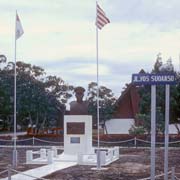
Most Indonesians considered the territory part of Indonesia on the grounds it had been part of the Dutch East Indies; but as its inhabitants were Melanesians and culturally completely different from Indonesians, the Dutch disagreed and instituted a program to prepare it for self rule. Education became a priority and a small elite among the Papuans developed an awareness that, like the neighbouring Australian-administered eastern half of the island, an independent state could be established in the future. A national parliament was elected in Hollandia in 1961. Sukarno however stepped up his campaign to take over western New Guinea, citing Dutch imperialism and throughout 1962 sent Indonesian forces to infiltrate by sea and air; this had little success as the local people failed to see the Indonesians as liberators: they attacked them or handed them to Dutch authorities. Commodore Yosaphat "Yos" Sudarso was killed in a sea battle, when the Indonesians tried to drop off 150 soldiers in Kaimana; his ship was sunk. The Indonesian action was a total failure, yet, it was an event that caused international involvement in the dispute and Sudarso was added to the list of "Heroes of the Revolution"; the large island in the south (formerly Frederik Hendrik Island) is named after him and so is the bay of Jayapura on the north coast, formerly Humboldt Bay.
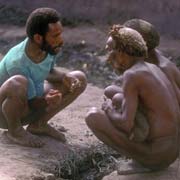
The Dutch accepted mediation by the Americans who, under Kennedy, were keen not to antagonise Sukarno, considered someone who could easily become too close to the Soviet Union and "Red China". Negotiations at the United Nations resulted in the New York Agreement of September 1962 in which authority was to be transferred to UNTEA (United Nations Temporary Executive Authority) and then on 1 May 1963 to Indonesia, with the proviso that the Indonesians would allow the Papuans to decide if they wanted to become independent or be a part of Indonesia. It was specified that all indigenous men and women in Papua had the right to vote. But six years later, when in July-August 1969, the UN-supervised "Act of Free Choice" was held, the Indonesians had 1,025 hand-picked men "unanimously agree" to remain part of Indonesia in their procedure of "Masyawarah" in which a consensus of "elders" was reached. It was reported that the men who had been selected for the vote had been insulted by gifts of clothing and cigarettes and were blackmailed into choosing independence with threats of violence against them; it has come to light that American diplomats realised it was anything but a fair vote, but, as it was considered "marginal to U.S. interests", they decided to drop it. Soon after, the territory, now called Irian Barat (West Irian) became Indonesia's 26th province. The name "Irian" had been promoted as far back as 1945 by Marcus Kaisiepo, brother of the future governor Frans Kaisiepo, who was in favour of integration with Indonesia. It was taken from the language of his native Biak Island, and meant "hot land rising from the sea". In 1973 the province was renamed "Irian Jaya", Jaya meaning "victory" in Sanskrit!
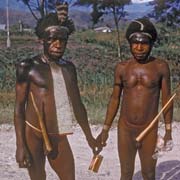
Indonesian rule meant in many instances brutal treatment of the local people, especially by the army. Muslim Javanese would look down on the tribes in the interior, where men would wear nothing but a "koteka", the penis gourd, women went topless and pigs were of great importance. In 1970 a campaign to clothe the Dani of the Baliem Valley, "Operasi Koteka", was carried out under military supervision when 6,000 kits containing clothing, an Indonesian flag and a picture of president Suharto were delivered to primary school students. This was aimed at making rapid changes and inculcate Indonesian "civilisation". But it had the opposite effect: the teaching of Bahasa Indonesia, forced identification as Indonesians and over-clothing are repugnant to the Dani and so is plundering their village gardens, enforced labour for road building, intrusion of the forests to rip out the timbers, general arrogance and cultural "superiority" of officials towards their way of life and the permanent military presence. Hated too is the policy of "Transmigrasi" in which thousands of people from the overcrowded Indonesian islands were moved to Papua. In 2010 the region had an estimated population of around 3.5 million people, with the interior still predominantly inhabited by ethnic Papuans and the coastal regions by a mixture of Papuans, Melanesians and Austronesians, including many Indonesians; the capital Jayapura now just looks like any Indonesian town. Some tribes in the vicinity of the capital have now died out. This policy of transmigration is one of the reasons of continuing unrest, as poor Indonesians are given jobs, leaving Papuans destitute in their own country. The Freeport Copper mine near Timika, where people who lived there have been expelled while the environment has been thoroughly polluted is another source of anger.
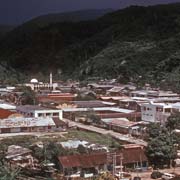
In 1963 Papuan leaders Nicolaas Jouwe, Marcus Kaisiepo and Herman Womsimor went into exile in the Netherlands, hoping to advance their cause in an international forum. Another leader, Eliezer Bonay, had become governor of West Irian under Sukarno and believed that Indonesian nationalism would guarantee and respect the wishes of West-Papuans: he was removed in 1964 as "unreliable", sent to Jakarta for "re-education" and arrested in 1965 for distributing anti-Indonesian documents favouring Papuan independence. He was imprisoned for his opposition to Indonesian rule, tortured and went into exile. Johan Ariks, a former seminarian, leader of the Arfak people near Manokwari and a founder of the Papuan Unity Party in 1960, refused from the start to cooperate with the Indonesians and continued the struggle for independence; he was tortured and died in prison in February 1967, aged 75. By March of that year it was claimed that in strafing raids and rocket attacks on villages the Indonesian air force had killed 1,000 people around Manokwari. By the end of that year whole villages had been razed in "Operation Destruction" and 3,500 villagers had been killed in the area. For over a year until 1968 the resistance among the Arfak was conducted from the mountains but continued strafing of villages, paratrooper drops, execution of leaders and starving of villagers forced many of the 15,000 Arfak people to come down from their mountain hamlets. Arfak leaders Lodewijk and Barend Mandatjan surrendered in January 1969; leader Frits Awom continued the resistance and although two extra infantry battalions were despatched, the Arfaks managed to hold off five to six times as many Indonesian soldiers. Resistance continued while the "Act of Free Choice" was being conducted in Manokwari. But eventually in 1970 Frits Awom surrendered on condition of amnesty: all leaders, in line of practice of Indonesia's New Order, were all summarily executed.
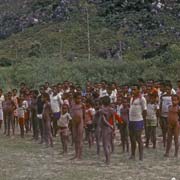
The Organisasi Papua Merdeka (OPM, Organisation for a Free Papua) was founded in the Biak-Numfor area in December 1963, with the announcement that "We do not want modern life! We refuse any kinds of development: religious groups, aid agencies, and governmental organisations just Leave Us Alone!". The OPM has been engaged in small-scale conflict with the Indonesian military since that time; there have been rebellions in remote mountain areas throughout the years and brutal reprisals by the Indonesian military. The movement is of course outlawed in Indonesia and hoisting the West-Papuan Morning Star Flag is considered an act of treason, a crime that carries a penalty of 7 to 20 years in jail. Nicolaas Jouwe, a member of the New Guinea Council, had drawn the attention of the United Nations to the oppression of the Papuan people by the Indonesian military, and, in response to the farcical "Act of Free Choice", had announced plans to declare independence; this was done on 1 July 1971 when two OPM commanders, Seth Jafeth Roemkorem and Jacob Hendrik Prai, declared a Republic of West-Papua, and drafted a constitution. However, this declaration was not recognised by Indonesia or any other country.
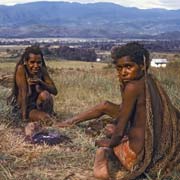
A proposal in 1999 to split the province into three sectors sparked Papuan protests and wasn't followed through. Although Indonesia had no intention loosening its grip, it did make some concessions on autonomy and reinvestment of the revenue taken out of the province after Suharto was deposed; president Abdurrahman Wahid on 26 December 2001 agreed to rename the province "Papua" as a concession to the West-Papuans; although "Irian" is the name in a number of local languages, it had become disliked as it had been imposed by Jakarta. In January 2003 however, President Megawati Sukarnoputri signed an order dividing Papua into three provinces: Central Irian Jaya, Papua (East Irian Jaya), and West Papua (West Irian Jaya); violent local protests prevented a government of the Central region being formed in August that year and Indonesian courts determined it to be unconstitutional anyway, as it violated Papua's special autonomy agreement. However, as the local government for the western region, now named "Irian Jaya Barat" (renamed "Papua Barat" in 2007) had already been installed in February that year, it remained, so now the territory was split into two, with a province of "West-Papua" created in the Bird's Head Peninsula and surrounding islands to its west.
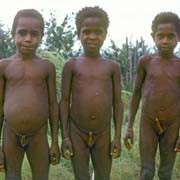
The OPM is still active and still dreams of freedom for the people of West-Papua, but Indonesia, benefiting from the region's natural riches, is not willing to even consider it; any act of defiance, like hoisting the Morning Star flag, is viciously dealt with by the military. It is estimated that since Indonesia's takeover more than 500,000 Papuans have been killed. Although there is sympathy abroad for the cause of Papuan freedom, no foreign government openly supports it: good relations with Indonesia is considered far more important. This was again shown on 25 June 2015 when the Melanesian Spearhead Group, during their summit meeting in the Solomon Islands, after the United Liberation Movement for West-Papua (founded in 2014) had applied to join the group, decided to admit Indonesia as an associate member instead, while the West-Papuans themselves were only be given observer status. It may be better than nothing, but, for now, Indonesia still keeps its brutal occupation and West-Papua's tragedy continues: villages burnt, Papuans arrested, tortured and shot and the beautiful natural wilderness devastated by logging, mining, agricultural and biofuel interests.
